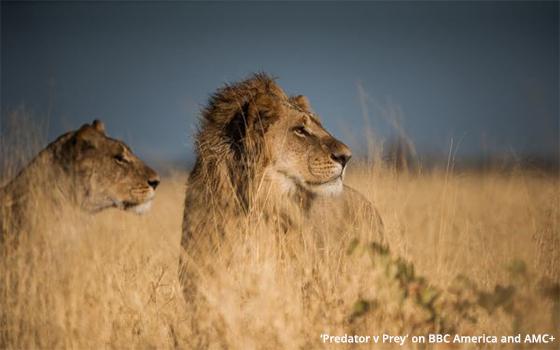Commentary
'Predator v Prey' Uses New FX Techniques For Close-Up Kills
- by Adam Buckman , Featured Columnist, April 19, 2024
Watching lions and other big predators track down, bring down and then chow down on their still living prey is not everybody’s cup of tea.
In fact, some wildlife documentaries still edit out the gory parts, even in this day and age of anything-goes TV.
Others, however, include the kill sequences and the feasts afterwards because showing these scenes is the very essence of these shows.
A new one that starts tomorrow on BBC America and co-owned AMC+ is titled “Predator v Prey,” so you know something is going to be dinner for something else.
In the one-hour premiere, the focus is on lions. I was unaware of this, but the famously maned male lions are not the hunters in a lion pride. It is the female who is the huntress-provider for her family.
advertisement
advertisement
In Episode One, she and members of her extended family dine al fresco on an impala (already killed by a leopard that Mama Lioness scares away), an African buffalo (also called a cape buffalo) and a zebra.
The show takes us step by step through the hunting process, which usually starts with a close-up of the hungry huntress licking her chops and surveying her surroundings in search of four-legged meat.
She then starts stalking, eventually springing from the underbrush to begin the chase. More often than not, she is aided in these pursuits by another lioness or two -- her sisters, says the show.
The show goes into great detail about the strategy and how it relates to the lioness’s natural instincts for expending her energy efficiently.
One of the challenges for her is this: While she can run faster than a zebra, for example, she can only keep up the pace for a relatively short time while the zebra has more stamina (and is a faster animal than you might think).
In the killing of a cape buffalo, which weighs far more than a lion, the lioness is shown jumping on the great beast’s back and digging her claws into its hide.
The show delves deeply into aspects of the lion’s physicality to explain how -- in this instance, for example -- the lioness is able to hold on while riding the back of a bucking cape buffalo because her sharp claws can be as long as three centimeters, enabling them to be driven deeply into her prey.
Then, when the animal is brought down, one of the lionesses clamps her jaws on its neck, breaking its windpipe and suffocating it.
While the buffalo writhes and then dies, other members of the pride are already tearing away its flesh and having at the animal’s innards.
All of the action is shown in extreme high definition in both close-up and long shots. Indeed, a press release for the show describes how this was done.
“Combining premium specialist archive footage and innovative new VFX techniques, each episode features a different species and reveals moment by moment the predatory features that are essential to survival within their world as they take on their worthy adversaries,” the release says.
“To bring to life these predator-prey interactions, a new 3D-graphics game engine is used to freeze and manipulate key instants within these killer moments to reveal the art of the hunt and the secrets of the kill.
“Exploring hidden perspectives, biology and behavior, all based on the latest scientific research, the engine provides an immersive, analytical and comprehensive view of life as a top predator in the most dramatic of ways.”
When watching the show, I detected a whiff of AI in the mix in the enhancing of some of the imagery, but how extensively I could not tell with my naked eye.
A Google search reveals that artificial intelligence is melding with the world of visual effects (VFX) these days.
Where “Predator v Prey” is concerned, the key word in the press release might be “immersive.”
“Artificial intelligence is revolutionizing the visual effects industry, making it possible to create more realistic, immersive [italics added] visuals than ever before,” wrote the Texas-based MediaTech Institute last August.
And so, the line between reality and “enhanced” reality is blurring. I can’t say it kept me from learning a great deal while watching “Predator v Prey.”
“Predator v Prey” premieres Saturday, April 20, at 8 p.m. Eastern on BBC America and AMC+.




